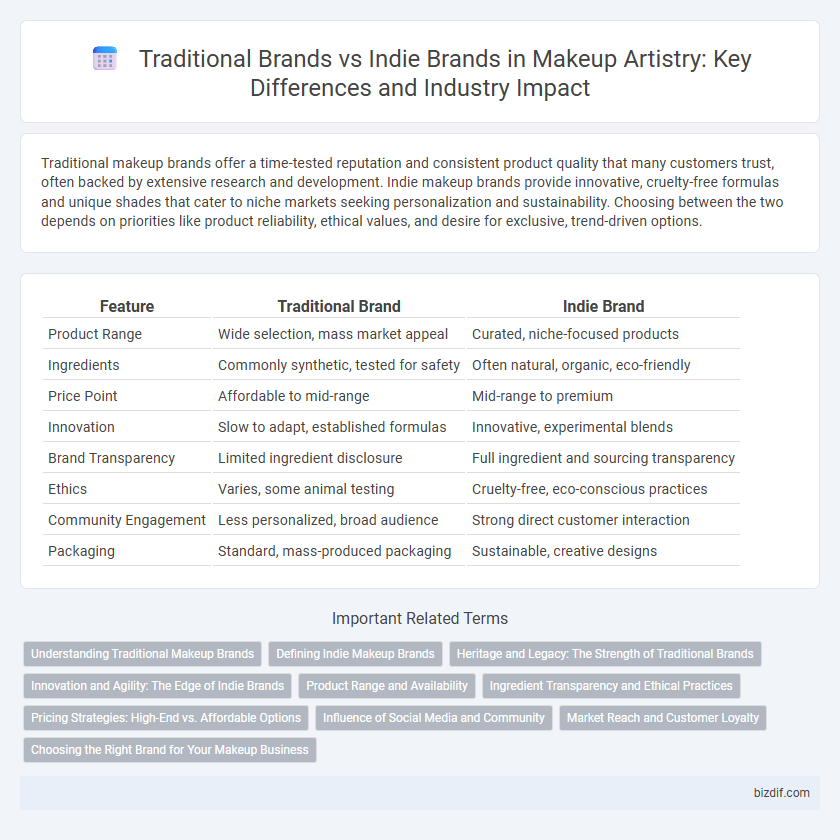Traditional makeup brands offer a time-tested reputation and consistent product quality that many customers trust, often backed by extensive research and development. Indie makeup brands provide innovative, cruelty-free formulas and unique shades that cater to niche markets seeking personalization and sustainability. Choosing between the two depends on priorities like product reliability, ethical values, and desire for exclusive, trend-driven options.
Table of Comparison
| Feature | Traditional Brand | Indie Brand |
|---|---|---|
| Product Range | Wide selection, mass market appeal | Curated, niche-focused products |
| Ingredients | Commonly synthetic, tested for safety | Often natural, organic, eco-friendly |
| Price Point | Affordable to mid-range | Mid-range to premium |
| Innovation | Slow to adapt, established formulas | Innovative, experimental blends |
| Brand Transparency | Limited ingredient disclosure | Full ingredient and sourcing transparency |
| Ethics | Varies, some animal testing | Cruelty-free, eco-conscious practices |
| Community Engagement | Less personalized, broad audience | Strong direct customer interaction |
| Packaging | Standard, mass-produced packaging | Sustainable, creative designs |
Understanding Traditional Makeup Brands
Traditional makeup brands are established companies with decades of market presence, known for consistent product quality, extensive research and development, and wide distribution networks. These brands often have iconic products and appeal to consumers seeking reliability and proven performance in makeup. Understanding their long-standing reputation and regulatory compliance helps makeup artists choose tested formulas for a professional and safe application.
Defining Indie Makeup Brands
Indie makeup brands prioritize innovative formulas and unique ingredient blends that differentiate them from traditional brands, often emphasizing cruelty-free and eco-friendly practices. These brands typically foster direct community engagement through social media platforms, enabling dynamic feedback and personalized product development. Indie brands also frequently challenge conventional beauty standards by offering inclusive shade ranges and niche product offerings tailored to diverse skin tones and preferences.
Heritage and Legacy: The Strength of Traditional Brands
Traditional makeup brands leverage decades of heritage, establishing trust through consistent quality and proven formulations that appeal to loyal customers. Their legacy is reinforced by iconic product lines and a reputation built on reliability, often supported by extensive research and development. Consumers associate these brands with expertise and time-tested performance, creating a strong emotional connection that indie brands are still developing.
Innovation and Agility: The Edge of Indie Brands
Indie makeup brands excel in innovation and agility by rapidly adapting to emerging trends and consumer demands, often introducing groundbreaking formulas and inclusive product ranges faster than traditional brands. Their flexibility allows for experimental textures, sustainable ingredients, and niche color palettes that resonate with diverse audiences, setting them apart in a competitive market. This dynamic approach empowers indie brands to lead industry evolution while traditional brands typically follow established, slower development cycles.
Product Range and Availability
Traditional makeup brands typically offer extensive product ranges covering basics to specialty items, with widespread availability in department stores, drugstores, and online retailers. Indie makeup brands often focus on niche products, unique formulations, and innovative shades, available primarily through their own websites or select boutique stores. Consumers seeking variety and convenience may prefer traditional brands, while those valuing exclusivity and creativity lean towards indie options.
Ingredient Transparency and Ethical Practices
Traditional makeup brands often prioritize long-established ingredient formulas, but may lack full transparency about sourcing and ethical practices. Indie brands typically emphasize clear ingredient transparency and ethical sourcing, appealing to consumers seeking cruelty-free, vegan, and sustainably produced products. This focus on ingredient clarity and ethical responsibility positions indie brands as leaders in clean beauty within the makeup artistry industry.
Pricing Strategies: High-End vs. Affordable Options
Traditional makeup brands often adopt high-end pricing strategies, leveraging established reputation, luxury packaging, and premium ingredients to justify elevated costs. Indie brands prioritize affordable options, targeting budget-conscious consumers while emphasizing unique formulations and cruelty-free or vegan certifications to differentiate in a competitive market. Pricing strategies in makeup artistry balance consumer perception of value with ingredient quality and brand identity to capture distinct market segments.
Influence of Social Media and Community
Social media platforms have transformed makeup artistry by amplifying the reach of indie brands through authentic community engagement and user-generated content, contrasting with the established marketing strategies of traditional brands. Indie brands thrive on niche audiences and influencer collaborations, leveraging platforms like Instagram and TikTok to build loyal, interactive communities that prioritize creativity and inclusivity. Traditional brands often maintain broad advertising campaigns but are increasingly adopting social media tactics to remain relevant amid the dynamic, community-driven indie market.
Market Reach and Customer Loyalty
Traditional makeup brands leverage extensive market reach through established retail partnerships and long-standing brand recognition, attracting a wide customer base. Indie brands often cultivate deeper customer loyalty by offering unique, innovative products and fostering personalized consumer engagement on social media platforms. Market reach for indie brands tends to be niche but highly targeted, while traditional brands dominate mass distribution channels.
Choosing the Right Brand for Your Makeup Business
Selecting the right makeup brand for your business involves evaluating product quality, innovation, and target market appeal; traditional brands often offer proven reliability and wide consumer trust, while indie brands provide unique, niche formulations that cater to emerging trends and diverse skin tones. Consider factors like ingredient transparency, cruelty-free certifications, and packaging ethics to align with your brand's values and customer expectations. Balancing established brand recognition with the fresh creativity of indie labels can maximize market reach and customer loyalty in the competitive beauty industry.
Traditional brand vs Indie brand Infographic

 bizdif.com
bizdif.com